Who would expect the famous fusiliers from the squadron commanded by Captain Frans Banning Cocq, as portrayed in 1642 by Rembrandt, to leave the canvas and to become a three dimensional bronze sculpture? But this time, not in the seventeenth century but in the twenty first century Holland.
The concept of this thoroughly unique project was conceived by two Russian sculptors – Mikhail Dronov and Alexander Taratynov. The history of art has known nothing of the kind to date. The sculptors have created something fundamental and professional. They have modelled, sculpted and cast in bronze the figures of the 22 fusiliers; their exuberant outfits, arms, and various accessories. They, as it were, threw down the gauntlet to, everyday perceptions of the famous “Nightwatch” painting.
So, at first you feel surprised and perplexed while getting acquainted with the Russian sculptors’ materialized idea; what on earth have they done it for? And this issue can be considered from several angles.
The first point of view: M. Dronov and A.Taratynov tried to breathe new life into the legendary classical work of art. “Rembrandt, the martyr of light-and-shade” (O.Mandelstam), solved problems of interaction of his characters on the flat surface of the canvas. Now, organizers of potential exhibitions may illuminate or put the Dutch fusiliers ‘in the shade’ in many different variations, creating a historical or modern background for them. Rembrandt’s characters are sculpted in the traditional realistic manner of the academic Russian school. Western Europe has already forgotten this school, commending itself completely to “high-brow” art-criticism scholastics lapsing into the newest fashionable tendencies.
The second point is that of a spectator. The purpose of the transition into bronze is to “give the spectator an opportunity to feel as if they are inside a painting” (A.Taratynov). Entering, playing, taking pictures, shooting videos of their relatives with the “Nightwatch” characters, and performing a kind of “spectators’ happening”. For children and adults this is ‘literally’ an act of getting inside of art. After this game interaction, the next meeting with the painting will be definitely perceived in a new way. A journey through the sculpture’s “looking glass” and back, to the Rijksmuseum halls, is a wonderful cognitive route from the twenty first century to the seventeenth century, back again.
From commercial and promotional point of view, this project by Dronov and Taratynov is absolutely unique. It’s no wonder the sculptors had their idea registered with the Russian copyright bureau and its counterpart in Washington D.C. Their project is a real museum godsend in many ways. This object should increase museum attendance, promoting the creative work of Rembrandt’s masterpiece, an event of news media proportion, and another reason to print postcards, brochures, calendars, posters, etc.
The “Nightwatch 3D” project is an innovation in the continuation of the original museum piece’s life. The fact that it is realized in the method of time-tested realistic sculpture does not, in any way, belittle its innovative importance.
William Mailand
September 2004, Moscow
The musketeers are coming back!
In front of the Chateau / hotel where in 1992 many heads of state stayed during the European Conference when the Treaty of Maastricht, Netherlands was concluded, now stands a group of musketeers with all their splendid regalia! This is not a masquerade or film. This is a prestigious group of cast bronze heroes from the Famouspainting Nightwatch (1642) by Rembrandt. This is a bronze monument to the painting, and, at the same time, the composition’s second life in three-dimension! This version of “Nightwatch” simultaneously becomes a monument to Rembrandt. But in fact is it a monument? It looks more like a substantive magic transformation.
Who dared to recreate the great Dutchman's canvas in the form of a sculpture?
The answer: sculptors Mikhail Dronov, of Moscow and Alexander Taratynov, who now lives in Holland.
The concept for the project seems to have occurred frequently, but this frequency, like the focus of a big lens, refracts many different circumstances. Taratynov’s studio, for many years, has been decorated with wallpaper reproducing a life-size reproduction of the “Nightwatch” painting. One day, it occurred to Dronov, seemingly of his own accord, to reproduce it in as a sculpture. Rembrandt ‘is’ after all a legendary personality! The sculptors were just on track with the master himself; and have now worked hard for many years. And true to the spirit of our times, the artists have implemented and promoted the project themselves.
The work went in stages, one figure after another. Modelled characters were put in front of an enormous reproduction of the painting and ‘ritually extruded’ from the flat counterparts. Each figure is independent and is set on a separate bronze plinth, one meter square. The cast figures were transported to the park in front of the hotel which is in the quietest part of Maastricht. Their future fate has not been decided, but the authors want to install the whole group in Rembrandt’s home town of Amsterdam. It is Sisyphean labour to recreate the whole squadron of larger then life size figures! It is also a Sisyphean labour to “justify” the project; to prove, persuade and cajole the minds of administrators and officials into acceptance.
Is recreation of pictorial art by means of sculpture new, has art history known anything of the kind? Of course, these types of creative work powerfully support each other; there has always been a certain interchange between the two. Pictorial art plays the role of a universal mirror. The connection between the two most dramatically manifested itself in baroque art. Palace and church interiors of the period feature a wide scope and magnitude of complicated visual effects. Transferred from flat illusionary shapes into three dimensional ones; a transformation of painting into sculpture. Doubtlessly, the very idea of a plastic metamorphosis, born by the baroque epoch, is close to Dronov and Taratynov.
The “Nightwatch” design opens outwardly, the characters are moving towards the spectator, at a point of “going beyond the frame”. They are eager to become three-dimensional. It is this effect, elicited by the master himself, which was realised by the sculptors.
Dronov and Taratynov did not copy the original; they “recreated” it, transferring it to a new dimension. But the recreation was documentarily accurate. Step by step, they recreated every figure in detail. Carefully, as precisely as possible, they modelled details of the arms, pleats on the clothes, fabric texture, the ornament embroidered on fabric and chased all in metal. Maintaining, above all, the quality of the portraiture. The authors tried to accurately portray the characters from the painting. Even though, not all the faces are painted clearly and the background has them partially overlapped or they are faintly seen in the light-and-dark of the medium. The sculptors conjectured the characters, looking for the right models, finding similar type.
Dronov and Taratynov live in different countries, but together they created an impressive, serial sculptural epic. A striking example of creative affinity and mutual understanding. Not only did they efficiently organized the work process, they, above all, determined a system of sculptural devices.
You can walk into a picture only in a fairytale. But you are able to walk into “Nightwatch”, examine the bronze characters close up. Mikhail .Dronov and AlexanderTaratynov created a monument; but not a static monument bound to one place. The monument is movable. It can be taken from city to city, set in various places with any combination of figures. The bronze warriors, like gigantic chessmen, may move around freely, forming new designs. Thus, in such an unusual way the life of the great canvas can be continued. Thus a new genre of this historic group portrait comes into being.
Dronov and Taratynov have played a game of chess. Whatever the final outcome, the game itself is impressive and beautiful, although not conducted with standard rules and regulations. In these terms the game has been played and is a success.
Sergey Orlov
We are facing semblant, deceitful evidence. On the face of it, this work is an incarnation of a concept beyond the plot, realization of a purely technical task: reproduction of a bidirectional scene in three dimensions.
But if it were only that, the work would be a question without an answer, something that is contrary to art.
However, the sight reveals that there is something more to it. And even if only that, the question remains: how is this possible? How can one understand, how can one see any coherence between two absolutely opposite tasks? For we are speaking of extracting characters out of the plastic system, where they exist only due to maintenance of necessary connections with everything around them.
Thus, the artist begins on an audacious project of breaking off the unbreakable.
Thus, monumental character of a work is mainly determined not by its concrete dimensions, but by its paradoxical character: it is simultaneously this thing and not quite this thing. So, a work as a gesture is at the same time the impossibility of the gesture. It is this contradiction that makes the basis for incorrigible frontality of the work, it is pointless to go round it. Going round this work, you get convinced every time of impossibility for this work to become what it is.
Gerard Desson
Moscow, 26 February 2003
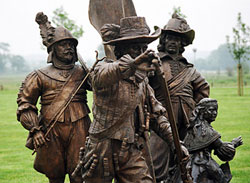

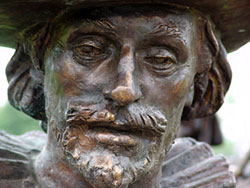
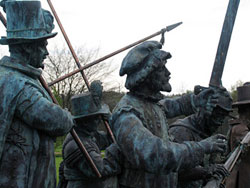
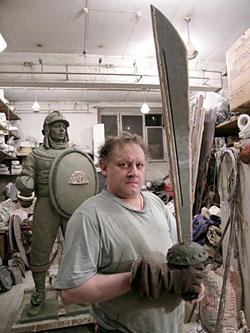
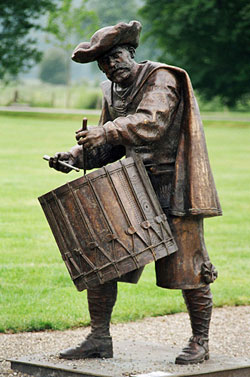
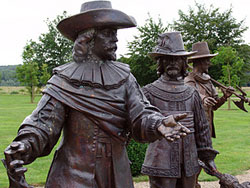
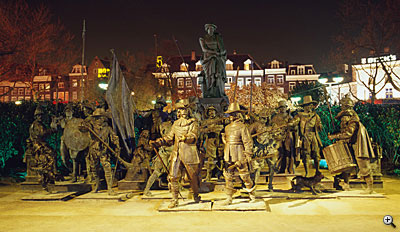
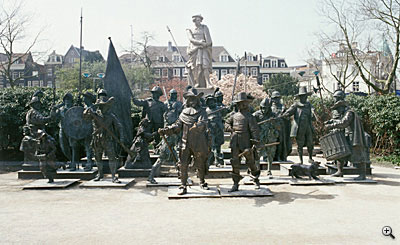
NIGHTWATCH 3D
The transformation of this two dimentional image into a three dimensional one will add a new reality to the Nightwatch and for the first time make visible the other side of the figures depicted in the most famous of Dutch paintings. This project was conceived and realized by two friends; Mikhail Dronov, of Moscow, and Alexander Taratynov, now living in Maastricht.
The idea of the project is that people will be able to view representations of historical characters living in Amsterdam in those old times. You will also be able to touch them and even walk among the figures from this world-famous masterpiece, a truly educational experience. This is a fully “sculptured” painting showing in more than full-length all twenty-two figures of the painting, even those figures that are not entirely visible on the canvas. It will certainly make make an indelible impression on the spectator.
Pending the agreements for its final location all the figures from the group (eighteen of the characters have arrived since spring 2005) are going to stay in the gardens of Chateau St. Gerlach nearby Maastricht. The whole sculpture with its separate figures is very striking also from the point of view of size. Its dimensions are 15 meter long, 7 meter in depth and 5 meter at its highest point.
Article from "NIVEAU" magazine.
VOORJAAR 2004. Netherlands
Cast bronze. 15x5x7m.